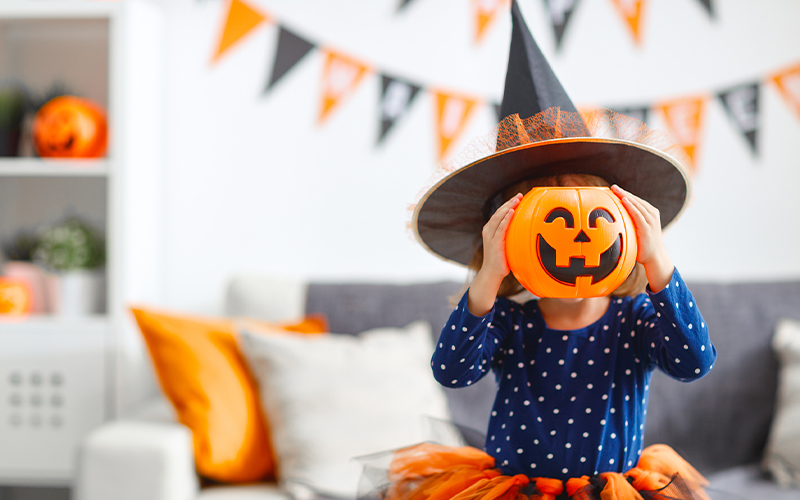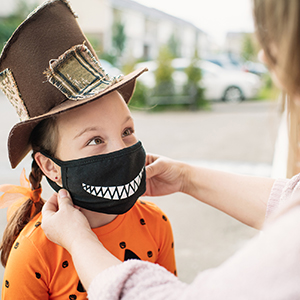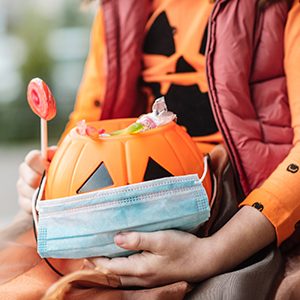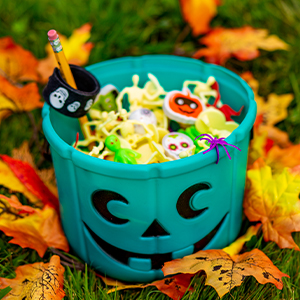How to Safely Celebrate Spooky Season
A Parents’ Guide to a Fab-boo-lous Halloween

Carving pumpkins, last minute trips to the costume store and stocking up on your favorite treats are all batty moments that make Halloween so eerie-sistable. But something else you should include in your haunted preparations this year is COVID-19.
While it may feel like having a fang-tastic time is witch-ful thinking, there are several ways to celebrate safely without sacrificing a gourd time. Help your child stay away from big, bad germs this year and celebrate spooky season safely by following these expert tips.
Ghost those ghoulish germs

To ensure you and your child have a fab-boo-lous time, minimize the risk of getting or spreading COVID-19 by:
- Choosing outdoor activities, such as a Halloween parade.
- Staying away from large crowds.
- Maintaining at least 6 feet of distance from those outside your household.
- Working a mask that covers your nose and mouth into your and your child’s Halloween costumes.
- Encouraging your child to wash their hands frequently.
Stason Vandegrift, MD. Pediatrics, Grayling Community Health Center said “For those who welcome trick-or-treaters, reduce contact by setting a table at the door with pre-portioned treats set out, rather than distributing treats directly. Do not hand out treats if you are feeling sick.”
Enjoy treats while avoiding tricks
Follow these tips to ensure your vampires and werewolves have a safe and un-boo-lievably fun Halloween.
- Stay with the pack. Young kids should always have a parent or other caregiver with them while trick-or-treating. If your older child or teen is trick-or -treating without you, encourage them to stay in a group and agree on a time when they’re expected to return home.
- Carry a flashlight. When trick-or-treating at night, encourage kids to carry a flashlight. Be sure to check that it has fresh batteries!
- Beware of stranger danger. Remind kids and teens to only go to homes that have a porch light on and to never to go inside someone’s home or car.
- Plan ahead. Before Halloween, plan out your trick-or-treating route. Check that it’s in a familiar and well-lit area.
-

Check the treats. Before your child enjoys their well-earned Halloween treats, go through their Halloween candy and throw away anything that has an open wrapper or appears to be tampered with.
- Don’t take unnecessary risks. Parents of children in costume, especially parents of “superheroes” should be on the lookout for high-risk behavior that imitates their favorite characters. Children on this holiday are more likely to try harmful stunts, such as jumping from high places in an attempt to “fly.” Have a discussion of make-believe versus what people can do in real life.
Eat, drink and be scary - while avoiding allergens
If your child is prone to reactions, be sure to take extra precautions so you don’t get caught in a sticky spider’s web of food allergies. Many of our favorite Halloween treats contain common allergens, including nuts, milk, egg, soy, or wheat.
If your child has a food allergy, make sure they bring an epinephrine auto-injector with them to their Halloween activities. Emphasize the importance of waiting until he or she is home to sort through and check treats to make sure they’re safe to eat.
Even if a particular candy is usually safe for your child, “fun size” or miniature versions can contain different ingredients. Checking the labels on each piece of candy will ensure your child can safely say Bone Appetit!
The Teal Pumpkin Project

is another solution for children with food allergies where families are encouraged to have non-food options on hand for trick-or-treaters. These are low-cost items such as glow sticks, bracelets, stickers or pencils that can be picked up at the dollar store or online. Be sure to avoid distributing smaller sized items that can be choking hazards for trick-or-treaters.
These trick-or-treating options give children with food allergies the chance to stay safe and have a ghoulish good time. Show your participation in the Teal Pumpkin Project by displaying a teal pumpkin by your door or by printing off a sign.
Don’t go out with bare bones. Dress for success!
Before your little zombie or mummy heads out on Halloween, make sure your child’s costume is safe.
- Choose costumes and accessories that are labeled as flame resistant. Carve out the extra risk of injury by checking that your child’s costume is flame resistant.
- Follow Edna’s advice – no capes! Edna Mode from The Incredibles had it right when she said, “no capes!” Avoid encircling accessories that pose a risk of strangulation.
- Ensure your child is both visible and can see clearly. Apply reflective material to costumes and treat bags to help make sure your child is visible in the dark. Also check hats and masks for a proper fit so they don’t affect your child’s ability to see. Instead of masks that can interfere with vision and lead to accidents, consider nontoxic makeup.
- Avoid colored contacts. While the idea of temporarily changing the color of your eyes sounds spook-tacular, they carry serious risk of eye complications, including loss of vision. Don’t let your child use decorative contact lenses unless they have been prescribed by an eye care professional.
- Dress for the weather. Make sure your child is equipped with warm clothes, a hat and mittens or gloves to ensure they don’t get cold when trick-or-treating.
Stay ahead of the carve with teens

To make sure your older witches and wizards have skele-fun while staying safe, make sure they have a charged cellphone, and you know where they will be and who they will be with if they will be attending events without you.
“Because teens are more likely to attend indoor activities such as haunted houses or Halloween parties with friends, talk to them about their COVID-19 strategy before Halloween,” said Dr. Vandegrift. “To reduce the risk of COVID-19 infection, have them try to avoid large indoor crowds, wear a mask that covers the nose and mouth and get vaccinated against COVID-19.”
Still have questions about keeping your goblins and ghouls safe this Halloween?
While these skeleton puns are humerous, if you still have any health questions call Munson Healthcare Ask-a-Nurse at 231-935-0951 to discuss symptoms. Our nurses are answering questions 24 hours a day at no charge to you (no insurance is required).